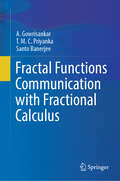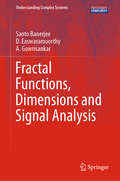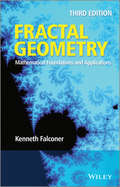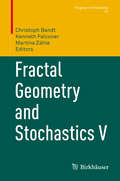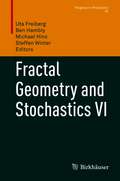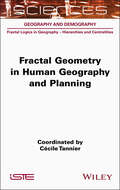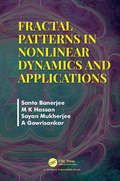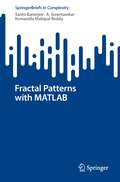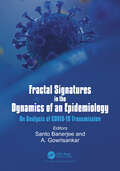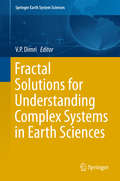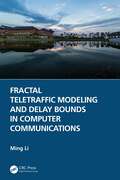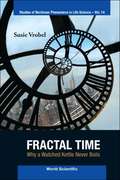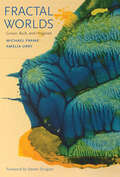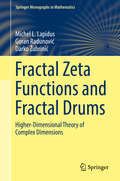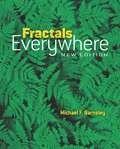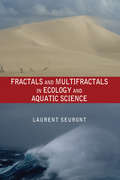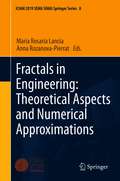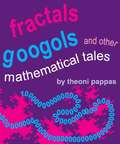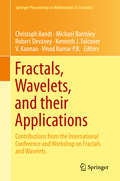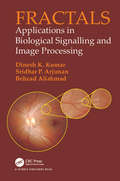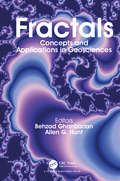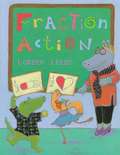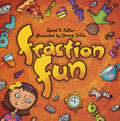- Table View
- List View
Fractal Functions Communication with Fractional Calculus
by Santo Banerjee A. Gowrisankar T. M. PriyankaThis book provides an in-depth examination of fractal functions, focusing on their self-similar structures and the relatively simple construction procedures that make them a subject of fascination in mathematics and engineering. By exploring fractal interpolation functions, the book sheds light on naturally occurring phenomena that exhibit irregularity and non-integer dimensions, offering a fresh perspective on these complex mathematical constructs. The chapters cover a range of topics, including the foundational principles of fractal geometry, the construction of fractal functions through iterated function systems, and the critical role of scaling parameters. Readers will find expert analyses of affine and non-affine fractal functions, as well as discussions on the application of fractional calculus methods such as the Riemann-Liouville and Caputo derivatives. The book also explores the practical applications of fractal interpolation in areas like epidemiology and climate dynamics, demonstrating the relevance of these mathematical concepts to real-world problems. This volume is an essential resource for researchers and scholars in mathematics, engineering, and related fields. It offers a comprehensive overview of the current research on fractal functions and fractional calculus, providing readers with the tools to understand and apply these concepts in their work. Whether you are an academic seeking to deepen your knowledge or a practitioner looking to apply fractal functions to practical challenges, this book is a valuable addition to your library. It invites you to engage with the latest research and explore the potential of fractal functions in addressing complex scientific and engineering problems.
Fractal Functions, Dimensions and Signal Analysis (Understanding Complex Systems)
by Santo Banerjee D. Easwaramoorthy A. GowrisankarThis book introduces the fractal interpolation functions (FIFs) in approximation theory to the readers and the concerned researchers in advanced level. FIFs can be used to precisely reconstruct the naturally occurring functions when compared with the classical interpolants. The book focuses on the construction of fractals in metric space through various iterated function systems. It begins by providing the Mathematical background behind the fractal interpolation functions with its graphical representations and then introduces the fractional integral and fractional derivative on fractal functions in various scenarios. Further, the existence of the fractal interpolation function with the countable iterated function system is demonstrated by taking suitable monotone and bounded sequences. It also covers the dimension of fractal functions and investigates the relationship between the fractal dimension and the fractional order of fractal interpolation functions. Moreover, this book explores the idea of fractal interpolation in the reconstruction scheme of illustrative waveforms and discusses the problems of identification of the characterizing parameters. In the application section, this research compendium addresses the signal processing and its Mathematical methodologies. A wavelet-based denoising method for the recovery of electroencephalogram (EEG) signals contaminated by nonstationary noises is presented, and the author investigates the recognition of healthy, epileptic EEG and cardiac ECG signals using multifractal measures. This book is intended for professionals in the field of Mathematics, Physics and Computer Science, helping them broaden their understanding of fractal functions and dimensions, while also providing the illustrative experimental applications for researchers in biomedicine and neuroscience.
Fractal Geometry
by Kenneth FalconerThe seminal text on fractal geometry for students and researchers: extensively revised and updated with new material, notes and references that reflect recent directions.Interest in fractal geometry continues to grow rapidly, both as a subject that is fascinating in its own right and as a concept that is central to many areas of mathematics, science and scientific research. Since its initial publication in 1990 Fractal Geometry: Mathematical Foundations and Applications has become a seminal text on the mathematics of fractals. The book introduces and develops the general theory and applications of fractals in a way that is accessible to students and researchers from a wide range of disciplines.Fractal Geometry: Mathematical Foundations and Applications is an excellent course book for undergraduate and graduate students studying fractal geometry, with suggestions for material appropriate for a first course indicated. The book also provides an invaluable foundation and reference for researchers who encounter fractals not only in mathematics but also in other areas across physics, engineering and the applied sciences.Provides a comprehensive and accessible introduction to the mathematical theory and applications of fractalsCarefully explains each topic using illustrative examples and diagramsIncludes the necessary mathematical background material, along with notes and references to enable the reader to pursue individual topicsFeatures a wide range of exercises, enabling readers to consolidate their understandingSupported by a website with solutions to exercises and additional material http://www.wileyeurope.com/fractalLeads onto the more advanced sequel Techniques in Fractal Geometry (also by Kenneth Falconer and available from Wiley)
Fractal Geometry and Stochastics V
by Kenneth Falconer Christoph Bandt Martina ZähleThis book collects significant contributions from the fifth conference on Fractal Geometry and Stochastics held in Tabarz, Germany, in March 2014. The book is divided into five topical sections: geometric measure theory, self-similar fractals and recurrent structures, analysis and algebra on fractals, multifractal theory, and random constructions. Each part starts with a state-of-the-art survey followed by papers covering a specific aspect of the topic. The authors are leading world experts and present their topics comprehensibly and attractively. Both newcomers and specialists in the field will benefit from this book.
Fractal Geometry and Stochastics VI (Progress in Probability #76)
by Ben Hambly Uta Freiberg Michael Hinz Steffen WinterThis collection of contributions originates from the well-established conference series "Fractal Geometry and Stochastics" which brings together researchers from different fields using concepts and methods from fractal geometry.Carefully selected papers from keynote and invited speakers are included, both discussing exciting new trends and results and giving a gentle introduction to some recent developments. The topics covered include Assouad dimensions and their connection to analysis, multifractal properties of functions and measures, renewal theorems in dynamics, dimensions and topology of random discrete structures, self-similar trees, p-hyperbolicity, phase transitions from continuous to discrete scale invariance, scaling limits of stochastic processes, stemi-stable distributions and fractional differential equations, and diffusion limited aggregation.Representing a rich source of ideas and a good starting point for more advanced topics in fractal geometry, the volume will appeal to both established experts and newcomers.
Fractal Geometry in Human Geography and Planning (ISTE Invoiced)
by Cécile TannierThe aim of this book is to provide an overview of the concepts and methods used in fractal analysis and modeling in order to study the spatial distribution of human settlements. The main concepts and mathematical tools are reviewed, and emphasis is placed on the practical benefits of their application and the pitfalls to be avoided when using them. The first part of the book is devoted to the basic concepts and geometric reference figures required for fractal analysis in human geography. In the second part, the principles of four major families of analysis methods are explained in detail: fractal analyses of point sequences, fractal methods for morphological delineation of urban agglomerations, multifractal analyses and cross scale signatures. The third part of the book is devoted to applications of fractal geometry in urban and regional planning.
Fractal Geometry: Mathematical Foundations And Applications
by Kenneth FalconerThe seminal text on fractal geometry for students and researchers: extensively revised and updated with new material, notes and references that reflect recent directions. Interest in fractal geometry continues to grow rapidly, both as a subject that is fascinating in its own right and as a concept that is central to many areas of mathematics, science and scientific research. Since its initial publication in 1990 Fractal Geometry: Mathematical Foundations and Applications has become a seminal text on the mathematics of fractals. The book introduces and develops the general theory and applications of fractals in a way that is accessible to students and researchers from a wide range of disciplines. Fractal Geometry: Mathematical Foundations and Applications is an excellent course book for undergraduate and graduate students studying fractal geometry, with suggestions for material appropriate for a first course indicated. The book also provides an invaluable foundation and reference for researchers who encounter fractals not only in mathematics but also in other areas across physics, engineering and the applied sciences. Provides a comprehensive and accessible introduction to the mathematical theory and applications of fractals Carefully explains each topic using illustrative examples and diagrams Includes the necessary mathematical background material, along with notes and references to enable the reader to pursue individual topics Features a wide range of exercises, enabling readers to consolidate their understanding Supported by a website with solutions to exercises and additional material http://www. wileyeurope. com/fractal Leads onto the more advanced sequel Techniques in Fractal Geometry (also by Kenneth Falconer and available from Wiley)
Fractal Geometry: Mathematical Foundations and Applications (Progress In Probability Ser. #70)
by Kenneth FalconerThe seminal text on fractal geometry for students and researchers: extensively revised and updated with new material, notes and references that reflect recent directions. Interest in fractal geometry continues to grow rapidly, both as a subject that is fascinating in its own right and as a concept that is central to many areas of mathematics, science and scientific research. Since its initial publication in 1990 Fractal Geometry: Mathematical Foundations and Applications has become a seminal text on the mathematics of fractals. The book introduces and develops the general theory and applications of fractals in a way that is accessible to students and researchers from a wide range of disciplines. Fractal Geometry: Mathematical Foundations and Applications is an excellent course book for undergraduate and graduate students studying fractal geometry, with suggestions for material appropriate for a first course indicated. The book also provides an invaluable foundation and reference for researchers who encounter fractals not only in mathematics but also in other areas across physics, engineering and the applied sciences. Provides a comprehensive and accessible introduction to the mathematical theory and applications of fractals Carefully explains each topic using illustrative examples and diagrams Includes the necessary mathematical background material, along with notes and references to enable the reader to pursue individual topics Features a wide range of exercises, enabling readers to consolidate their understanding Supported by a website with solutions to exercises and additional material http://www.wileyeurope.com/fractal Leads onto the more advanced sequel Techniques in Fractal Geometry (also by Kenneth Falconer and available from Wiley)
Fractal Patterns in Nonlinear Dynamics and Applications: Patterns in Nonlinear Dynamics and Applications
by Sayan Mukherjee Santo Banerjee M K Hassan A GowrisankarMost books on fractals focus on deterministic fractals as the impact of incorporating randomness and time is almost absent. Further, most review fractals without explaining what scaling and self-similarity means. This book introduces the idea of scaling, self-similarity, scale-invariance and their role in the dimensional analysis. For the first time, fractals emphasizing mostly on stochastic fractal, and multifractals which evolves with time instead of scale-free self-similarity, are discussed. Moreover, it looks at power laws and dynamic scaling laws in some detail and provides an overview of modern statistical tools for calculating fractal dimension and multifractal spectrum.
Fractal Patterns with MATLAB (SpringerBriefs in Complexity)
by Santo Banerjee A. Gowrisankar Komandla Mahipal ReddyThis book presents the iterative beauty of fractals and fractal functions graphically with the aid of MATLAB programming. The fractal images generated using the MATLAB codes provide visual delight and highly encourage the fractal lovers for creative thinking. The book compiles five cutting-edge research chapters, each with state-of-the art fractal illustrations. It starts with the fundamental theory for the construction of fractal sets via the deterministic iteration algorithm. Incorporating the theoretical base, fractal illustrations of elementary fractal sets are provided with the explicit MATLAB code. The book gives examples of MATLAB codes to present the fractal surfaces. This book is contributed to all the research beginners as well as the professionals on the field of fractal analysis. As it covers basic fractals like Sierpinski triangle to advanced fractal functions with explicit MATLAB code, the presented fractal illustrations hopefully benefit even the non-field readers. The book is a useful course to all the research beginners on the fractal and fractal-related fields.
Fractal Signatures in the Dynamics of an Epidemiology: An Analysis of COVID-19 Transmission
by Santo Banerjee A. GowrisankarThe recent Covid-19 pandemic threw the world into complete chaos with its rapid and devastating spread. Scientists are still trying to obtain a better understanding of the patterns of COVID-19 and trying to get a deeper understanding of mutant strains and their pathogenicity by performing genomic sequences of more samples. Fractal-based analysis provides its unique forecasting policy to reduce the spread of COVID-19, and in general, of any outbreaks. The book presents fractal and multifractal models of COVID-19 and reviews the impact of the pandemic including epidemiology, genome organization, transmission cycle, and control strategies based on mathematical models towards developing an immune intervention. Also, it covers non-clinical aspects such as economic development with graphical illustrations, meeting the needs of onlookers outside the sector who desire additional information on the epidemic. The fractal signatures describe the fractal textures in the patterns of Corona virus. Studies on the epidemiology of Covid-19 in relation with the fractals and fractal functions serve to exhibit its irregular chaotic nature. Moreover, the book with its wide coverage on the Hurst exponent analysis and the fractal dimension estimation, greatly aids in measuring the epidemiology.
Fractal Solutions for Understanding Complex Systems in Earth Sciences
by V. P. DimriThis book deals with fractals in understanding problems encountered in earth science, and their solutions. It starts with an analysis of two classes of methods (homogeneous fractals random models, and homogeneous source distributions or "one point" distributions) widely diffused in the geophysical community, especially for studying potential fields and their related source distributions. Subsequently, the use of fractals in potential fields is described by scaling spectral methods for estimation of curie depth. The book also presents an update of the use of the fractal concepts in geological understanding of faults and their significance in geological modelling of hydrocarbon reservoirs. Geophysical well log data provide a unique description of the subsurface lithology; here, the Detrended Fluctuation Analysis technique is presented in case studies located off the west-coast of India. Another important topic is the fractal model of continuum percolation which quantitatively reproduce the flow path geometry by applying the Poiseuille's equation. The pattern of fracture heterogeneity in reservoir scale of natural geological formations can be viewed as spatially distributed self-similar tree structures; here, the authors present simple analytical models based on the medium structural characteristics to explain the flow in natural fractures. The Fractal Differential Adjacent Segregation (F-DAS) is an unconventional approach for fractal dimension estimation using a box count method. The present analysis provides a better understanding of variability of the system (adsorbents - adsorbate interactions). Towards the end of book, the authors discuss multi-fractal scaling properties of seismograms in order to quantify the complexity associated with high-frequency seismic signals. Finally, the book presents a review on fractal methods applied to fire point processes and satellite time-continuous signals that are sensitive to fire occurrences.
Fractal Teletraffic Modeling and Delay Bounds in Computer Communications
by Ming LiBy deploying time series analysis, Fourier transform, functional analysis, min-plus convolution, and fractional order systems and noise, this book proposes fractal traffic modeling and computations of delay bounds, aiming to improve the quality of service in computer communication networks. As opposed to traditional studies of teletraffic delay bounds, the author proposes a novel fractional noise, the generalized fractional Gaussian noise (gfGn) approach, and introduces a new fractional noise, generalized Cauchy (GC) process for traffic modeling. Researchers and graduates in computer science, applied statistics, and applied mathematics will find this book beneficial. Ming Li, PhD, is a professor at Ocean College, Zhejiang University, and the East China Normal University. He has been an active contributor for many years to the fields of computer communications, applied mathematics and statistics, particularly network traffic modeling, fractal time series, and fractional oscillations. He has authored more than 200 articles and 5 monographs on the subjects. He was identified as the Most Cited Chinese Researcher by Elsevier in 2014–2020. Professor Li was recognized as a top 100,000 scholar in all fields in 2019–2020 and a top 2% scholar in the field of Numerical and Computational Mathematics in 2021 by Prof. John P. A. Ioannidis, Stanford University.
Fractal Time: Why a Watched Kettle Never Boils (Studies of Nonlinear Phenomena in Life Science, Volume 14)
by Susie VrobelThis book provides an interdisciplinary introduction to the notion of fractal time, starting from scratch with a philosophical and perceptual puzzle.
Fractal Worlds: Grown, Built, and Imagined
by Michael Frame Amelia UrryFractal geometry is a uniquely fascinating area of mathematics, exhibited in a range of shapes that exist in the natural world, from a simple broccoli floret to a majestic mountain range. In this essential primer, mathematician Michael Frame—a close collaborator with Benoit Mandelbrot, the founder of fractal geometry—and poet Amelia Urry explore the amazing world of fractals as they appear in nature, art, medicine, and technology. Frame and Urry offer new insights into such familiar topics as measuring fractal complexity by dimension and the life and work of Mandelbrot. In addition, they delve into less-known areas: fractals with memory, the Mandelbrot set in four dimensions, fractals in literature, and more. An inviting introduction to an enthralling subject, this comprehensive volume is ideal for learning and teaching.
Fractal Zeta Functions and Fractal Drums: Higher-Dimensional Theory of Complex Dimensions (Springer Monographs in Mathematics)
by Michel L. Lapidus Goran Radunović Darko ŽubrinićThis monograph gives a state-of-the-art and accessible treatment of a new general higher-dimensional theory of complex dimensions, valid for arbitrary bounded subsets of Euclidean spaces, as well as for their natural generalization, relative fractal drums. It provides a significant extension of the existing theory of zeta functions for fractal strings to fractal sets and arbitrary bounded sets in Euclidean spaces of any dimension. Two new classes of fractal zeta functions are introduced, namely, the distance and tube zeta functions of bounded sets, and their key properties are investigated. The theory is developed step-by-step at a slow pace, and every step is well motivated by numerous examples, historical remarks and comments, relating the objects under investigation to other concepts. Special emphasis is placed on the study of complex dimensions of bounded sets and their connections with the notions of Minkowski content and Minkowski measurability, as well as on fractal tube formulas. It is shown for the first time that essential singularities of fractal zeta functions can naturally emerge for various classes of fractal sets and have a significant geometric effect. The theory developed in this book leads naturally to a new definition of fractality, expressed in terms of the existence of underlying geometric oscillations or, equivalently, in terms of the existence of nonreal complex dimensions. The connections to previous extensive work of the first author and his collaborators on geometric zeta functions of fractal strings are clearly explained. Many concepts are discussed for the first time, making the book a rich source of new thoughts and ideas to be developed further. The book contains a large number of open problems and describes many possible directions for further research. The beginning chapters may be used as a part of a course on fractal geometry. The primary readership is aimed at graduate students and researchers working in Fractal Geometry and other related fields, such as Complex Analysis, Dynamical Systems, Geometric Measure Theory, Harmonic Analysis, Mathematical Physics, Analytic Number Theory and the Spectral Theory of Elliptic Differential Operators. The book should be accessible to nonexperts and newcomers to the field.
Fractals Everywhere: New Edition
by Michael F. Barnsley"Difficult concepts are introduced in a clear fashion with excellent diagrams and graphs." — Alan E. Wessel, Santa Clara University"The style of writing is technically excellent, informative, and entertaining." — Robert McCartyThis new edition of a highly successful text constitutes one of the most influential books on fractal geometry. An exploration of the tools, methods, and theory of deterministic geometry, the treatment focuses on how fractal geometry can be used to model real objects in the physical world. Two sixteen-page full-color inserts contain fractal images, and a bonus CD of an IFS Generator provides an excellent software tool for designing iterated function systems codes and fractal images. Suitable for undergraduates and graduate students of many backgrounds, the treatment starts with an introduction to basic topological ideas. Subsequent chapters examine transformations on metric spaces, dynamics on fractals, fractal dimension and interpolation, Julia sets, and parameter spaces. A final chapter introduces measures on fractals and measures in general. Problems and tools emphasize fractal applications, and an answers section contains solutions and hints.
Fractals and Multifractals in Ecology and Aquatic Science
by Laurent SeurontEcologists sometimes have a less-than-rigorous background in quantitative methods, yet research within this broad field is becoming increasingly mathematical. Written in a step-by-step fashion, Fractals and Multifractals in Ecology and Aquatic Science provides scientists with a basic understanding of fractals and multifractals and the techniques fo
Fractals in Engineering: Theoretical Aspects and Numerical Approximations (SEMA SIMAI Springer Series #8)
by Maria Rosaria Lancia Anna Rozanova-PierratFractal structures or geometries currently play a key role in all models for natural and industrial processes that exhibit the formation of rough surfaces and interfaces. Computer simulations, analytical theories and experiments have led to significant advances in modeling these phenomena across wild media. Many problems coming from engineering, physics or biology are characterized by both the presence of different temporal and spatial scales and the presence of contacts among different components through (irregular) interfaces that often connect media with different characteristics. This work is devoted to collecting new results on fractal applications in engineering from both theoretical and numerical perspectives. The book is addressed to researchers in the field.
Fractals, Googols, and Other Mathematical Tales
by Theoni PappasA treasure trove of stories that make mathematical ideas come to life. Explores math concepts and topics such as real numbers, exponents, dimensions, the golden rectangle in both serious and humorous ways. Stories such as the parable of p, the number line that fell apart, Leonhard the magic turtle and many others offer an amusing and entertaining way to explore and share mathematical ideas regardless of age or background. The reference section following each story is designed as enrichment information for the concepts presented in each story.
Fractals, Wavelets, and their Applications
by Christoph Bandt Michael Barnsley Robert Devaney Kenneth J. Falconer V. Kannan Vinod Kumar P.B.Fractals and wavelets are emerging areas of mathematics with many common factors which can be used to develop new technologies. This volume contains the selected contributions from the lectures and plenary and invited talks given at the International Workshop and Conference on Fractals and Wavelets held at Rajagiri School of Engineering and Technology, India from November 9-12, 2013. Written by experts, the contributions hope to inspire and motivate researchers working in this area. They provide more insight into the areas of fractals, self similarity, iterated function systems, wavelets and the applications of both fractals and wavelets. This volume will be useful for the beginners as well as experts in the fields of fractals and wavelets.
Fractals: Applications in Biological Signalling and Image Processing
by Dinesh Kumar Sridhar P. Arjunan Behzad AliahmadThe book provides an insight into the advantages and limitations of the use of fractals in biomedical data. It begins with a brief introduction to the concept of fractals and other associated measures and describes applications for biomedical signals and images. Properties of biological data in relations to fractals and entropy, and the association with health and ageing are also covered. The book provides a detailed description of new techniques on physiological signals and images based on the fractal and chaos theory. The aim of this book is to serve as a comprehensive guide for researchers and readers interested in biomedical signal and image processing and feature extraction for disease risk analyses and rehabilitation applications. While it provides the mathematical rigor for those readers interested in such details, it also describes the topic intuitively such that it is suitable for audience who are interested in applying the methods to healthcare and clinical applications. The book is the outcome of years of research by the authors and is comprehensive and includes other reported outcomes.
Fractals: Concepts and Applications in Geosciences
by Behzad Ghanbarian Allen G. HuntThis book provides theoretical concepts and applications of fractals and multifractals to a broad range of audiences from various scientific communities, such as petroleum, chemical, civil and environmental engineering, atmospheric research, and hydrology. In the first chapter, we introduce fractals and multifractals from physics and math viewpoints. We then discuss theory and practical applications in detail. In what follows, in chapter 2, fragmentation process is modeled using fractals. Fragmentation is the breaking of aggregates into smaller pieces or fragments, a typical phenomenon in nature. In chapter 3, the advantages and disadvantages of two- and three-phase fractal models are discussed in detail. These two kinds of approach have been widely applied in the literature to model different characteristics of natural phenomena. In chapter 4, two- and three-phase fractal techniques are used to develop capillary pressure curve models, which characterize pore-size distribution of porous media. Percolation theory provides a theoretical framework to model flow and transport in disordered networks and systems. Therefore, following chapter 4, in chapter 5 the fractal basis of percolation theory and its applications in surface and subsurface hydrology are discussed. In chapter 6, fracture networks are shown to be modeled using fractal approaches. Chapter 7 provides different applications of fractals and multifractals to petrophysics and relevant area in petroleum engineering. In chapter 8, we introduce the practical advantages of fractals and multifractals in geostatistics at large scales, which have broad applications in stochastic hydrology and hydrogeology. Multifractals have been also widely applied to model atmospheric characteristics, such as precipitation, temperature, and cloud shape. In chapter 9, these kinds of properties are addressed using multifractals. At watershed scales, river networks have been shown to follow fractal behavior. Therefore, the applications of fractals are addressed in chapter 10. Time series analysis has been under investigations for several decades in physics, hydrology, atmospheric research, civil engineering, and water resources. In chapter 11, we therefore, provide fractal, multifractal, multifractal detrended fluctuation analyses, which can be used to study temporal characterization of a phenomenon, such as flow discharge at a specific location of a river. Chapter 12 addresses signals and again time series using a novel fractal Fourier analysis. In chapter 13, we discuss constructal theory, which has a perspective opposite to fractal theories, and is based on optimizationof diffusive exchange. In the case of river drainages, for example, the constructal approach begins at the divide and generates headwater streams first, rather than starting from the fundamental drainage pattern.
Fraction Fun
by David A. AdlerWould you rather eat 1/4 of a pizza or 1/8 of a pizza? Find 3/4 of a dollar or 1/10 of a dollar? Confused? You don't have to be! Fractions are made easy in this simple and hands-on math concept book. You'll learn what the top and bottom numbers are called, and what they mean. You will also find out how to recognize and compare different fractions. Just follow the clear instructions and you will learn the most important thing of all -- that fractions can be fun!
